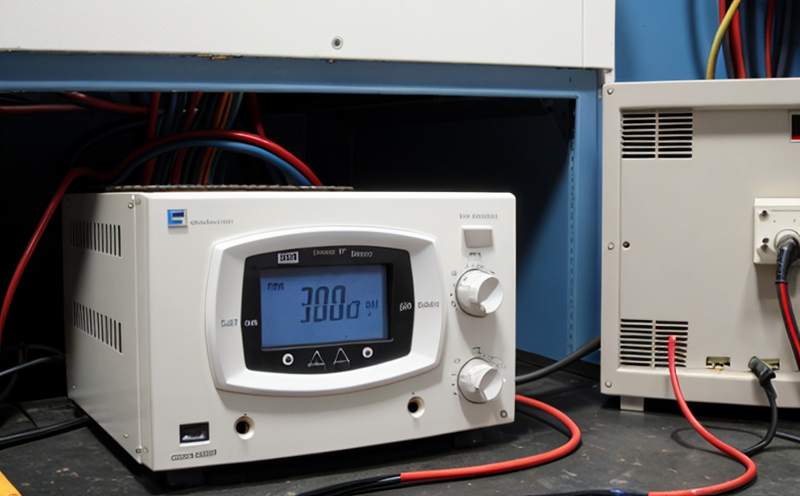IEC 61000 4 2 Electrostatic Discharge Immunity Testing for Lighting Equipment
The International Electrotechnical Commission (IEC) standard IEC 61000-4-2 is a crucial guide in ensuring that electrical and electronic equipment, including lighting fixtures, can withstand electrostatic discharges (ESD). This standard defines the procedures to test the immunity of such devices against ESD. Electrostatic discharge is an omnipresent phenomenon, particularly in environments where static electricity may accumulate due to friction or other factors.
The importance of this testing extends beyond compliance; it ensures product reliability and enhances customer satisfaction by guaranteeing that lighting equipment functions correctly under real-world conditions. In industries like automotive, healthcare, and aerospace, the integrity of electrical systems is paramount for both safety and operational efficiency. Compliance with IEC 61000-4-2 not only helps avoid costly disruptions but also ensures a competitive edge in the market.
During testing, specimens are subjected to a series of controlled ESD events using specific test equipment designed to simulate real-world scenarios. The standard specifies various levels and types of discharge to ensure thorough evaluation. This includes contact discharges (C1-C4) and air-gap discharges (A1-A3). Each level is calibrated to reflect different environmental conditions, thereby providing a comprehensive assessment of the lighting fixture's robustness against ESD.
Preparation for testing involves careful selection and configuration of test parameters. These include defining the type of discharge, voltage levels, and duration. The specimen must also be prepared in its final assembly configuration, including all connected components. This ensures that the test results accurately reflect the device's performance as it would be used in a real-world application.
The testing equipment typically consists of an electrostatic generator capable of producing the specified discharge events. The setup includes a Faraday cage to contain the discharge and a controlled environment to ensure consistent conditions during testing. The specimen is placed within this environment, and the test sequence begins with pre-discharge checks to verify the integrity of the system.
Post-test analysis involves reviewing the performance data to determine if the lighting equipment has met the specified criteria for immunity against ESD. Compliance typically requires that the device maintains its operational parameters within acceptable limits after exposure to the defined discharge events. Reports generated from these tests provide detailed insights into the device's robustness, highlighting any potential areas for improvement.
By adhering to IEC 61000-4-2 standards, manufacturers can ensure that their lighting equipment meets global safety and quality requirements. This not only facilitates easier market entry but also enhances brand reputation by demonstrating a commitment to excellence in product design and manufacturing.
Applied Standards
The IEC 61000-4 family of standards covers various aspects of electromagnetic compatibility (EMC), including the effects of electromagnetic interference. Specifically, IEC 61000-4-2 focuses on electrostatic discharge immunity testing. This standard is widely recognized and applied in numerous sectors where electrical and electronic equipment is used.
- IEC 61000-4-2: Defines the procedures for conducting ESD tests to ensure that lighting fixtures can withstand electrostatic discharges.
- ISO/IEC 17025: Ensures that testing laboratories are capable of providing accurate and reliable results, which is critical for meeting IEC standards.
- ASTM F48: Provides additional guidelines for ESD test procedures, often used in conjunction with IEC standards.
The application of these standards ensures that lighting equipment is tested to the highest international quality and safety standards. Compliance with these standards not only guarantees product reliability but also facilitates market entry into regions that have stringent EMC regulations.
Industry Applications
The IEC 61000-4-2 standard is particularly relevant in sectors where lighting fixtures are exposed to environmental factors that can generate static electricity. These include industrial facilities, healthcare settings, and outdoor environments. In these areas, the robustness of lighting equipment against ESD becomes a critical factor for operational reliability.
For instance, in industrial settings, where machinery generates significant friction, the risk of ESD is high. Ensuring that lighting fixtures are immune to such discharges can prevent malfunctions and downtime, which are costly disruptions in production processes. In healthcare environments, where continuous operation is essential, reliable lighting equipment ensures uninterrupted services.
Outdoor installations also benefit from this testing. Weather conditions and the presence of dust and other particles can lead to static build-up, making ESD immunity crucial for maintaining the integrity of outdoor lighting systems. By adhering to IEC 61000-4-2 standards, manufacturers can ensure that their products perform reliably under diverse environmental conditions.
Competitive Advantage and Market Impact
The implementation of IEC 61000-4-2 testing provides significant competitive advantages in the market. Firstly, it enhances product reliability, which is a key factor for consumers and businesses alike. Reliable lighting equipment ensures that installations run smoothly without unexpected disruptions, thus improving overall efficiency.
- Increased Market Access: Compliance with international standards like IEC 61000-4-2 opens doors to global markets where stringent EMC regulations are in place.
- Enhanced Reputation: Demonstrating adherence to high-quality testing standards builds trust and strengthens brand reputation among consumers and industry stakeholders.
- Improved Customer Satisfaction: Reliable products lead to higher customer satisfaction, which can translate into repeat business and positive word-of-mouth.
- Potential Cost Savings: By identifying and addressing potential issues during the testing phase, manufacturers can avoid costly recalls and warranty claims post-market launch.
In a competitive market, these advantages provide a solid foundation for growth and sustainability. Moreover, compliance with international standards such as IEC 61000-4-2 not only meets regulatory requirements but also sets a benchmark for excellence in product design and manufacturing.





